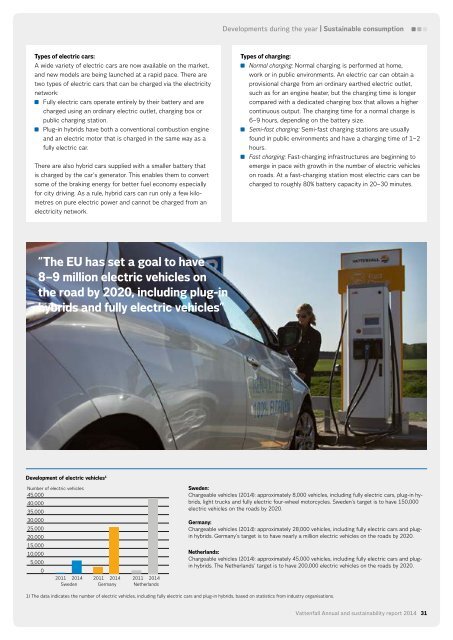annual-and-sustainability-report-2014
annual-and-sustainability-report-2014
annual-and-sustainability-report-2014
You also want an ePaper? Increase the reach of your titles
YUMPU automatically turns print PDFs into web optimized ePapers that Google loves.
Developments during the year | Sustainable consumptionTypes of electric cars:A wide variety of electric cars are now available on the market,<strong>and</strong> new models are being launched at a rapid pace. There aretwo types of electric cars that can be charged via the electricitynetwork:Fully electric cars operate entirely by their battery <strong>and</strong> arecharged using an ordinary electric outlet, charging box orpublic charging station.Plug-in hybrids have both a conventional combustion engine<strong>and</strong> an electric motor that is charged in the same way as afully electric car.There are also hybrid cars supplied with a smaller battery thatis charged by the car’s generator. This enables them to convertsome of the braking energy for better fuel economy especiallyfor city driving. As a rule, hybrid cars can run only a few kilometreson pure electric power <strong>and</strong> cannot be charged from anelectricity network.Types of charging:Normal charging: Normal charging is performed at home,work or in public environments. An electric car can obtain aprovisional charge from an ordinary earthed electric outlet,such as for an engine heater, but the charging time is longercompared with a dedicated charging box that allows a highercontinuous output. The charging time for a normal charge is6–9 hours, depending on the battery size.Semi-fast charging: Semi-fast charging stations are usuallyfound in public environments <strong>and</strong> have a charging time of 1–2hours.Fast charging: Fast-charging infrastructures are beginning toemerge in pace with growth in the number of electric vehicleson roads. At a fast-charging station most electric cars can becharged to roughly 80% battery capacity in 20–30 minutes.”The EU has set a goal to have8–9 million electric vehicles onthe road by 2020, including plug-inhybrids <strong>and</strong> fully electric vehicles”Development of electric vehicles 1Number of electric vehicles45,00040,00035,00030,00025,00020,00015,00010,0005,00002011 <strong>2014</strong> 2011 <strong>2014</strong> 2011 <strong>2014</strong>Sweden Germany Netherl<strong>and</strong>sSweden:Chargeable vehicles (<strong>2014</strong>): approximately 8,000 vehicles, including fully electric cars, plug-in hybrids,light trucks <strong>and</strong> fully electric four-wheel motorcycles. Sweden’s target is to have 150,000electric vehicles on the roads by 2020.Germany:Chargeable vehicles (<strong>2014</strong>): approximately 28,000 vehicles, including fully electric cars <strong>and</strong> pluginhybrids. Germany’s target is to have nearly a million electric vehicles on the roads by 2020.Netherl<strong>and</strong>s:Chargeable vehicles (<strong>2014</strong>): approximately 45,000 vehicles, including fully electric cars <strong>and</strong> pluginhybrids. The Netherl<strong>and</strong>s’ target is to have 200,000 electric vehicles on the roads by 2020.1) The data indicates the number of electric vehicles, including fully electric cars <strong>and</strong> plug-in hybrids, based on statistics from industry organisations.Vattenfall Annual <strong>and</strong> <strong>sustainability</strong> <strong>report</strong> <strong>2014</strong> 31



